CCNA v7 Modules 1 – 2: OSPF Concepts and Configuration Exam Answers
NOTE: If you have a new question on this test, please comment Question and Multiple-Choice list in form below this article. We will update answers for you in the shortest time. Thank you! We truly value your contribution to the website
Q1. What is the format of the router ID on an OSPF-enabled router?
- a unique router host name that is configured on the router
- a unique phrase with no more than 16 characters
- a 32-bit number formatted like an IPv4 address
- an 8-bit number with a decimal value between 0 and 255
- a character string with no space
Q2. What is the reason for a network engineer to alter the default reference bandwidth parameter when configuring OSPF?
- to force that specific link to be used in the destination route
- to more accurately reflect the cost of links greater than 100 Mb/s
- to enable the link for OSPF routing
- to increase the speed of the link
Q3. Match the description to the term. (Not all options are used.)

Q4. In an OSPFv2 configuration, what is the effect of entering the command network 192.168.1.1 0.0.0.0 area 0 ?
- It changes the router ID of the router to 192.168.1.1.
- It allows all 192.168.1.0 networks to be advertised.
- It tells the router which interface to turn on for the OSPF routing process.
- It enables OSPF on all interfaces on the router.
Q5. Open the PT Activity. Perform the tasks in the activity instructions and then answer the question.

Which task has to be performed on Router 1 for it to establish an OSPF adjacency with Router 2?
- Issue the clear ip ospf process command.
- Change the subnet mask of interface FastEthernet 0/0 to 255.255.255.0.
- Remove the passive interface command from interface FastEthernet 0/0.
- Add the network 10.0.1.0 0.0.0.255 area 0 command to the OSPF process.
Q6. After modifying the router ID on an OSPF router, what is the preferred method to make the new router ID effective?
- HQ# copy running-config startup-config
- HQ# clear ip ospf process
- HQ# clear ip route *
- HQ# resume
Q7. An administrator is configuring single-area OSPF on a router. One of the networks that must be advertised is 64.102.0.0 255.255.255.128. What wildcard mask would the administrator use in the OSPF network statement?
- 0.0.31.255
- 0.0.0.63
- 0.0.63.255
- 0.0.0.127
Q8. Which step in the link-state routing process is described by a router sending Hello packets out all of the OSPF-enabled interfaces?
- injecting the default route
- exchanging link-state advertisements
- establishing neighbor adjacencies
- electing the designated router
Q9. Refer to the exhibit. A network administrator has configured OSPFv2 on the two Cisco routers but PC1 is unable to connect to PC2. What is the most likely problem?

- Interface S0/0 is configured as a passive-interface on router R2.
- Interface Fa0/0 is configured as a passive-interface on router R2.
- Interface Fa0/0 has not been activated for OSPFv2 on router R2.
- Interface s0/0 has not been activated for OSPFv2 on router R2.
Q10. What command would be used to determine if a routing protocol-initiated relationship had been made with an adjacent router?
- show ip protocols
- show ip interface brief
- ping
- show ip ospf neighbor
CCNA 3 v7 Modules 1 – 2: OSPF Concepts and Configuration Exam Answers
Q11. Refer to the exhibit. If the switch reboots and all routers have to re-establish OSPF adjacencies, which routers will become the new DR and BDR?
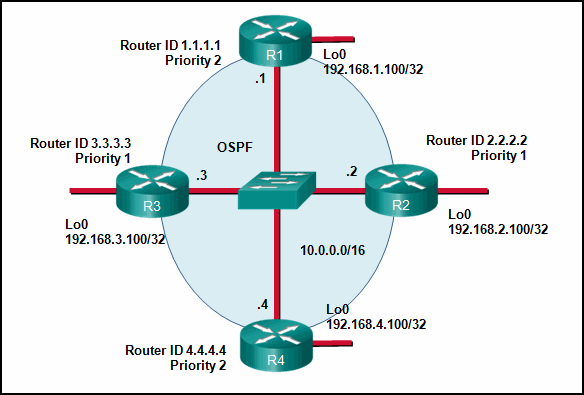
- Router R4 will become the DR and router R1 will become the BDR.
- Router R2 will become the DR and router R3 will become the BDR.
- Router R1 will become the DR and router R2 will become the BDR.
- Router R4 will become the DR and router R3 will become the BDR.
Q12. Refer to the exhibit. What is the OSPF cost to reach the router A LAN 172.16.1.0/24 from B?
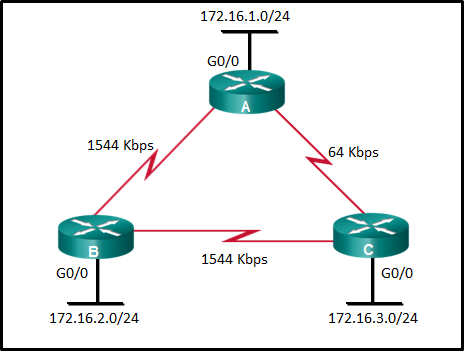
- 782
- 74
- 128
- 65
Q13. What is the recommended Cisco best practice for configuring an OSPF-enabled router so that each router can be easily identified when troubleshooting routing issues?
- Configure a value using the router-id command.
- Use the highest active interface IP address that is configured on the router.
- Use a loopback interface configured with the highest IP address on the router.
- Use the highest IP address assigned to an active interface participating in the routing process.
Q14. Refer to the exhibit. Which command did an administrator issue to produce this output?
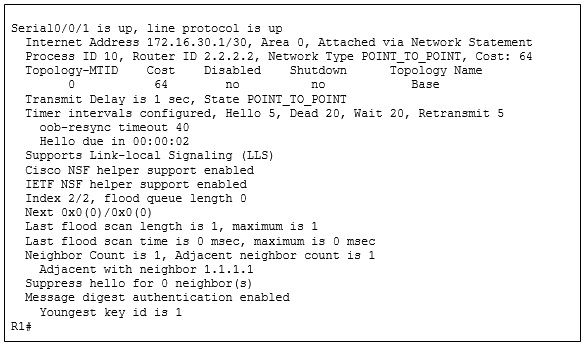
- R1# show ip ospf
- R1# show ip route ospf
- R1# show ip ospf interface serial0/0/1
- R1# show ip ospf neighbor
Q15. What are the two purposes of an OSPF router ID? (Choose two.)
- to facilitate the transition of the OSPF neighbor state to Full
- to uniquely identify the router within the OSPF domain
- to facilitate router participation in the election of the designated router
- to enable the SPF algorithm to determine the lowest cost path to remote networks
- to facilitate the establishment of network convergence
Q16. Refer to the exhibit. If no router ID was manually configured, what would router Branch1 use as its OSPF router ID?
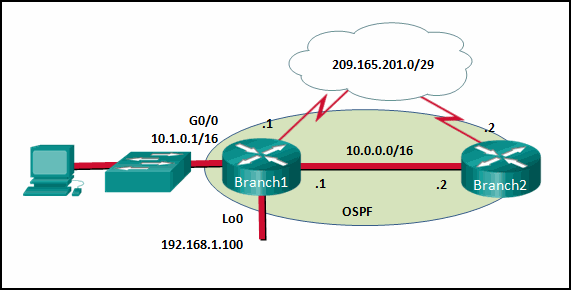
- 10.0.0.1
- 10.1.0.1
- 192.168.1.100
- 209.165.201.1
Q17. A network technician issues the following commands when configuring a router:
R1(config)# router ospf 11 R1(config-router)# network 10.10.10.0 0.0.0.255 area 0
What does the number 11 represent?
- the administrative distance that is manually assigned to R1
- the cost of the link to R1
- the area number where R1 is located
- the autonomous system number to which R1 belongs
- the OSPF process ID on R1
Q17. What will an OSPF router prefer to use first as a router ID?
- the highest active interface that participates in the routing process because of a specifically configured network statement
- any IP address that is configured using the router-id command
- a loopback interface that is configured with the highest IP address on the router
- the highest active interface IP that is configured on the router
Q18. Which command is used to verify that OSPF is enabled and also provides a list of the networks that are being advertised by the network?
- show ip interface brief
- show ip route ospf
- show ip protocols
- show ip ospf interface
Q19. Refer to the exhibit. Suppose that routers B, C, and D have a default priority, and router A has a priority 0. Which conclusion can be drawn from the DR/BDR election process?
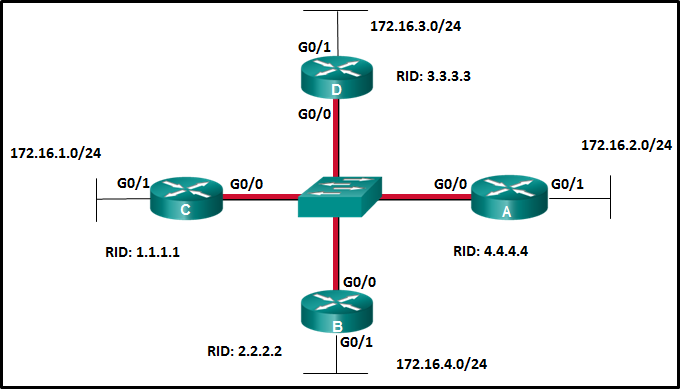
- If the priority of router C is changed to 255, then it will become the DR.
- Router A will become the DR and router D will become the BDR.
- If the DR fails, the new DR will be router B.
- If a new router with a higher priority is added to this network, it will become the DR.
Q20. Refer to the exhibit. Which three statements describe the results of the OSPF election process of the topology that is shown in the exhibit? (Choose three.)
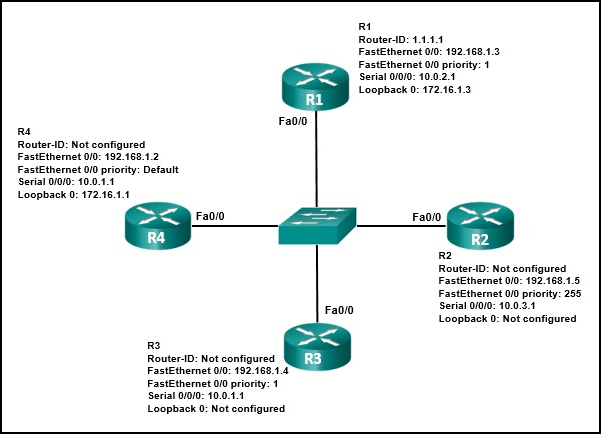
- The router ID on R2 is the loopback interface.
- R3 will be elected BDR.
- R2 will be elected DR.
- The R4 router ID is 172.16.1.1.
- R1 will be elected BDR.
- The R4 FastEthernet 0/0 priority is 128.
CCNA 3 v7 Modules 1 – 2: OSPF Concepts and Configuration Exam Answers
Q21. Refer to the exhibit. On which router or routers would a default route be statically configured in a corporate environment that uses single area OSPF as the routing protocol?
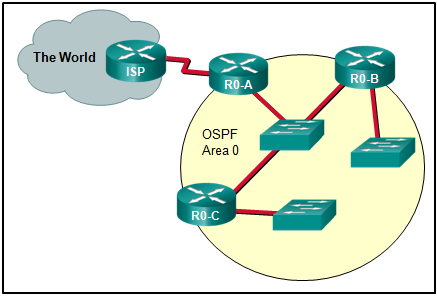
- ISP and R0-A
- ISP
- R0-A
- R0-B and R0-C
- ISP, R0-A, R0-B, and R0-C
- R0-A, R0-B, and R0-C
CCNAv7 System Test Course (Version 1.1) – System Test Exam Answers
Q22. An OSPF router has three directly connected networks; 172.16.0.0/16, 172.16.1.0/16, and 172.16.2.0/16. Which OSPF network command would advertise only the 172.16.1.0 network to neighbors?
- outer(config-router)# network 172.16.1.0 0.0.255.255 area 0
- router(config-router)# network 172.16.0.0 0.0.15.255 area 0
- router(config-router)# network 172.16.1.0 255.255.255.0 area 0
- router(config-router)# network 172.16.1.0 0.0.0.0 area 0
Q23. Which type of OSPFv2 packet contains an abbreviated list of the LSDB of a sending router and is used by receiving routers to check against the local LSDB?
- link-state update
- link-state request
- database description
- link-state acknowledgment
Q24. Match the OSPF state with the order in which it occurs. (Not all options are used.)

Q25. Which three OSPF states are involved when two routers are forming an adjacency? (Choose three.)
- ExStart
- Down
- Loading
- Init
- Two-way
- Exchange
Q26. What is a benefit of multiarea OSPF routing?
- Routers in all areas share the same link-state database and have a complete picture of the entire network.
- Topology changes in one area do not cause SPF recalculations in other areas.
- A backbone area is not required.
- Automatic route summarization occurs by default between areas.
Q27. What is the default router priority value for all Cisco OSPF routers?
- 0
- 1
- 10
- 255
Q28. When an OSPF network is converged and no network topology change has been detected by a router, how often will LSU packets be sent to neighboring routers?
- every 5 minutes
- every 10 minutes
- every 30 minutes
- every 60 minutes
Q29. Refer to the exhibit. A network administrator has configured the OSPF timers to the values that are shown in the graphic. What is the result of having those manually configured timers?

- The R1 dead timer expires between hello packets from R2.
- The neighbor adjacency has formed.
- R1 automatically adjusts its own timers to match the R2 timers.
- The hello timer on R2 expires every ten seconds.
Q30. To establish a neighbor adjacency two OSPF routers will exchange hello packets. Which two values in the hello packets must match on both routers? (Choose two.)
- hello interval
- router priority
- dead interval
- router ID
- list of neighbors
CCNA 3 v7 Modules 1 – 2: OSPF Concepts and Configuration Exam Answers
CCNAv7 System Test Course (Version 1.1) – System Test Exam Answers
Q31. What is used to facilitate hierarchical routing in OSPF?
- the election of designated routers
- autosummarization
- frequent SPF calculations
- the use of multiple areas
Q32. Match each OSPF packet type to how it is used by a router. (Not all options are used.)

Q33. An administrator is configuring single-area OSPF on a router. One of the networks that must be advertised is 128.107.0.0 255.255.252.0. What wildcard mask would the administrator use in the OSPF network statement?
- 0.0.0.7
- 0.0.63.255
- 0.0.3.255
- 0.0.0.3
Q34. By default, what is the OSPF cost for any link with a bandwidth of 100 Mb/s or greater?
- 1
- 100
- 10000
- 100000000
Q35. Which command will a network engineer issue to verify the configured hello and dead timer intervals on a point-to-point WAN link between two routers that are running OSPFv2?
- show ip ospf interface serial 0/0/0
- show ip ospf neighbor
- show ipv6 ospf interface serial 0/0/0
- show ip ospf interface fastethernet 0/1
Q36. Which step in the link-state routing process is described by a router building a link-state database based on received LSAs?
- selecting the router ID
- declaring a neighbor to be inaccessible
- executing the SPF algorithm
- building the topology table
Q37. Which OSPF data structure is identical on all OSPF routers that share the same area?
- forwarding database
- link-state database
- adjacency database
- routing table
Q38. In an OSPF network when are DR and BDR elections required?
- when all the routers in an OSPF area cannot form adjacencies
- when the two adjacent neighbors are in two different networks
- when the two adjacent neighbors are interconnected over a point-to-point link
- when the routers are interconnected over a common Ethernet network
Q39. What indicates to a link-state router that a neighbor is unreachable?
- if the router no longer receives routing updates
- if the router no longer receives hello packets
- if the router receives an LSP with previously learned information
- if the router receives an update with a hop count of 16
Q40. Which step does an OSPF-enabled router take immediately after establishing an adjacency with another router?
- builds the topology table
- executes the SPF algorithm
- chooses the best path
- exchanges link-state advertisements
Q41. What type of address is 64.101.198.197?
- public
- private
Join Our Telegram For PDF Download
CCNA 3 v7 Modules 1 – 2: OSPF Concepts and Configuration Exam Answers
NOTE: If you have a new question on this test, please comment Question and Multiple-Choice list in form below this article. We will update answers for you in the shortest time. Thank you! We truly value your contribution to the website
CCNAv7 System Test Course (Version 1.1) – System Test Exam Answers
1 thought on “CCNA v7 Modules 1 – 2: OSPF Concepts and Configuration Exam Answers”